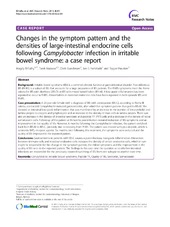| dc.contributor.author | El-Salhy, Magdy | en_US |
| dc.contributor.author | Mazzawi, Tarek | en_US |
| dc.contributor.author | Gundersen, Doris | en_US |
| dc.contributor.author | Hatlebakk, Jan Gunnar | en_US |
| dc.contributor.author | Hausken, Trygve | en_US |
| dc.date.accessioned | 2013-11-08T08:13:28Z | |
| dc.date.available | 2013-11-08T08:13:28Z | |
| dc.date.issued | 2013-09-29 | eng |
| dc.Published | BMC Research Notes 6(1):391 | eng |
| dc.identifier.issn | 1756-0500 | |
| dc.identifier.uri | https://hdl.handle.net/1956/7515 | |
| dc.description.abstract | Background Irritable bowel syndrome (IBS) is a common chronic functional gastrointestinal disorder. Post-infectious IBS (PI-IBS) is a subset of IBS that accounts for a large proportion of IBS patients. The PI-IBS symptoms meet the Rome criteria for IBS with diarrhoea (IBS-D) or IBS with mixed bowel habits (IBS-M). A low-grade inflammation has been reported to occur in PI-IBS. Abnormalities in intestinal endocrine cells have been reported in both sporadic IBS and PI-IBS. Case presentation A 20-year-old female with a diagnosis of IBS with constipation (IBS-C), according to Rome III criteria, contracted Campylobacter-induced gastroenteritis, after which her symptom pattern changed to IBS-M. She showed an intestinal low-grade inflammation that was manifested by an increase in the number of intraepithelial and lamina propria leucocytes and lymphocytes and an increase in the density of mast cells in lamina propria. There was also an increase in the density of intestinal serotonin and peptide YY (PYY) cells and a decrease in the density of rectal somatostatin cells. Follow-up of the patient at 4-months post-infection revealed reduction of IBS symptoms and an improvement in her quality of life. However, 6 months following the Campylobacter infection, the patient switched back from IBS-M to IBS-C, probably due to recovery from PI-IBS. The patient was treated with prucalopride, which is serotonin 5HT4 receptor agonist. Six months later following this treatment, the symptoms were reduced and the quality of life improved in the reported patient. Conclusions Gastroenteritis in patients with IBS-C causes a post-infectious, low-grade inflammation. Interaction between immune-cells and intestinal endocrine cells increases the density of certain endocrine cells, which in turn might be responsible for the change in the symptom pattern, the milder symptoms and the improvement in the quality of life seen in the reported patient. The findings in this case raise the question as to whether intestinal infections are responsible for the previously reported switching of IBS from one subtype to another over time. | en_US |
| dc.language.iso | eng | eng |
| dc.publisher | BioMed Central Ltd. | eng |
| dc.rights | Attribution CC BY | eng |
| dc.rights.uri | http://creativecommons.org/licenses/by/2.0 | eng |
| dc.subject | Campylobacter | eng |
| dc.subject | Irritable bowel syndrome | eng |
| dc.subject | Peptide YY | eng |
| dc.subject | Quality of life | eng |
| dc.subject | Serotonin | eng |
| dc.subject | Somatostatin | eng |
| dc.title | Changes in the symptom pattern and the densities of large-intestinal endocrine cells following Campylobacter infection in irritable bowel syndrome: a case report | en_US |
| dc.type | Peer reviewed | |
| dc.type | Journal article | |
| dc.date.updated | 2013-10-02T03:50:34Z | |
| dc.description.version | publishedVersion | en_US |
| dc.rights.holder | Copyright 2013 El-Salhy et al.; licensee BioMed Central Ltd. This is an Open Access article distributed under the terms of the Creative Commons Attribution License (http://creativecommons.org/licenses/by/2.0), which permits unrestricted use, distribution, and reproduction in any medium, provided the original work is properly cited. | |
| dc.rights.holder | Magdy El-Salhy et al.; licensee BioMed Central Ltd. | |
| dc.identifier.doi | https://doi.org/10.1186/1756-0500-6-391 | |
| dc.identifier.cristin | 1053707 | |

